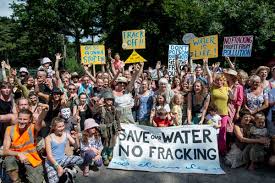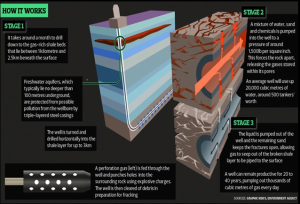Methane the purified form of natural Gas. A simple colourless, odourless compound with the chemical formula CH4. We can identify it because organic sulphur compounds are added to the commercial gas to make it detectable by smell. We rely on its highly exothermic combustion for our heating, cooking and hot water systems, but now a new highly debated technique has been developed for its extraction: Hydraulic fracturing or hydrofracturing, commonly known as fracking.
This is a technique in which a vast quantity of water is mixed with chemical compounds to create a fracking fluid which is introduced at high pressures of up to 1,500lb per square inch into a wellbore up to 1-2.5km below the surface (See diagram). The pressure creates the fractures within the rock along which fluids such as trapped natural gases, petroleum based compounds, and other solutions are more likely to transfer to the well. The hydraulic fracture is kept open with the introduction of small grains of proppant such as chemically treated sand or man-made ceramic materials. Composition of these introduced environmental contaminants depends on the type of fracturing used, but many of the chemicals are not available for public scrutiny and can range from gel to foam or slickwater-based. The technique is now increasingly used in wells for shale gas to extract natural gas and as such the environmental consequences which are been discovered are becoming far more numerous.
( click image to enlarge)
What are the environmental impacts of fracking and are there links to seismic induced events like in Blackpool 2011, water contamination and fugitive emissions ?
Fracking operations produce fugitive emissions, which include: methane, carbon dioxide and nitrous oxide emissions that do not come from a stack, duct or vent. They could undermine any carbon benefits of using shale gas over coal, because methane emissions from shale gas are at least 30% higher than from conventional gas extraction techniques. At a press conference on fracking, Robert Howarth, an ecologist and evolutionary biologist, and Anthony Ingraffea, a civil and environmental engineer, reported that fracked wells leak 40 to 60% more methane than conventional natural gas wells. When water with its chemical load is forced down a well to break the shale, it flows back up and is stored in large ponds or tanks. But volumes of methane also flow back up the well at the same time and are released into the atmosphere before they can be captured, and molecule for molecule, methane traps 20 to 25 times more heat in the atmosphere than carbon dioxide. The effect dissipates faster, but airborne methane remains in the atmosphere for about 12 years contributing to the greenhouse effect.
Waste products include salts, metals and naturally occurring radioactive materials found deep within rocks which seep into waste water supplies and concentrate where it accumulates. These would need to be transferred to a specialised waste disposal facility, at considerable expense and logistical cost.
Fracking also requires considerable amounts of water. It exhausts the water available for public supply, a healthy environment and agriculture use and requires considerable treatment afterwards. The waste products associated with fracking include the gases been extracted such as methane which can permeate into the aquifiers by ground disturbances cause by the fracking process. This is because the aquifiers are a body of permeable rock that can contain or transmit groundwater and often overlie shale gas reserves. So water is needed for the mining process, but the processes itself can contaminant vast quantities of ground water found in aquifiers. Also chemicals used in the process can enter the same aquifiers through fractures or poor handling of surface waste water. Is it coincidence or a cause effect that areas of water stress also coincide with areas of shale gas development?
Shale gas extraction requires high pressure injection of chemicals, sand and water into the ground. This can lead to contamination of ground water, aquifers and wetland sites through poorly cased wells.
Is the evidence for substantial seismic events a myth?

Above anti-fracking protesters near Cuadrilla’s oil drilling operation in Balcombe.
The company responsible for cuadrila admits that:
“It is highly probable that the hydraulic fracturing of Cuadrilla’s Preese Hall-1 well did trigger a number of minor seismic events.”
These same small events which registered 2.3 on the Richter scale in April 2011. But is this an isolated incident restricted to one country and one area? Unfortunately not, investigations have shown that the earthquakes in Ohio in January 2012 were blamed on disposal of contaminated water from the fracking process into underground structures.
Such seismic events and disruption from fracking will be greater in the UK than vast countries like the US because of the close proximity to densely populated areas and areas of high environmental value and biodiversity, water resources and infra-structure.
Will the consumer get cheaper gas?
A report by the British geological survey, estimates 1,300 trillion cubic feet of shale gas may lie beneath a band of Northern England stretching from Blackpool to the Humber estuary. Based on us extraction rates 10% of this reserve can be recovered the equivalent of 77 years North Sea gas extraction and enough to supply domestic demands for 40 years. Although other industry experts dispute nowhere near these figures could be achieved. The local people are being patted on the back for their tolerance with £100,000 for the local community and 1% of flow revenues. In Britain the resource is deemed to belong to the crown and not the land owner. But is the extraction worth its value? Will we all be able to heat our homes in winter and not worry about the cost because the gas supply is bountiful and cheap?
Should all the obstacles for environmental safety be met with, will the result be lower gas prices for consumers? Well it will probably come as no surprise that in a recent report by the commons energy and climate change committee it was said “it is too early to say whether domestic production of shale could result in cheaper gas prices in the UK… it is unlikely that the US experience will be directly replicated in the UK because of differences in geology, public attitudes, regulations and technological uncertainties” and one might be cynical to say high profit margins the industry has been getting quite comfortable with for many years.
Here the average annual household bill for gas and electricity is now about £1,200, more than double what it was in 2004, according to U-switch. It predicts this will rise to £1,582 by 2015 and £2,766 by 2018. In 2009 the poorest 20% of the population spent 7.8% of their income on domestic fuel, whereas the wealthiest 20% spent 3.7% and between 2003-10 households spending more than 10% rose from 6% up to 16%. Does it strike the reader with a certain irony that most of the proposed fracking sites are in the poorer parts of the country? Is it surprising that Britain has the highest rate of elderly winter deaths from hypothermia in Europe? Does it surprise the reader that politicians don’t feel the collective shiver because MP’s can claim for utility bills? The solution is not simple, but industry experts have said there are over 40 years’ worth of natural gas from current mining in the North Sea. This could be 40 years in which we could perfect and fully investigate the implications of fracking and implement policies which are not ill-thought and give short term gain which leave substantial consequences for generations to come.



